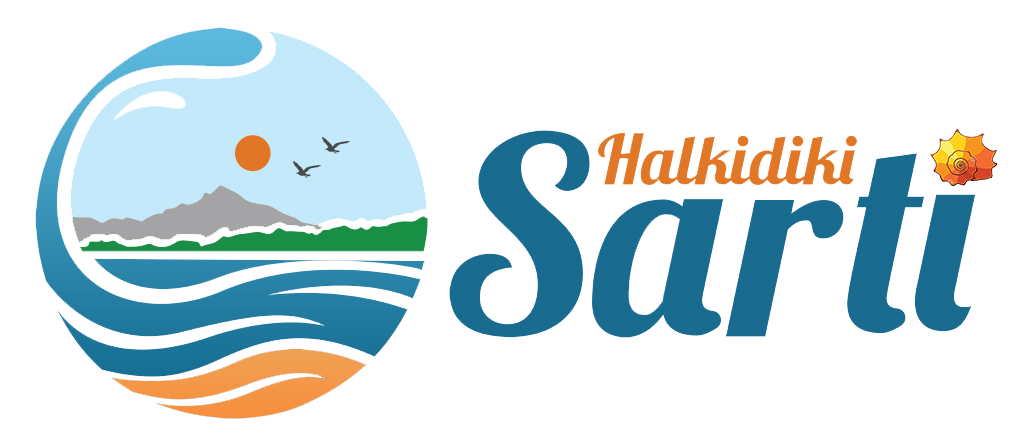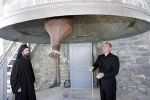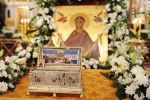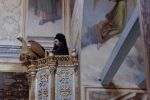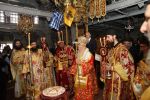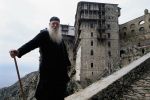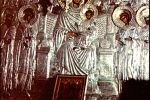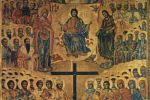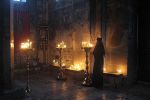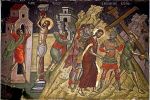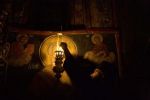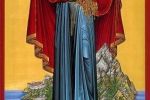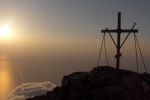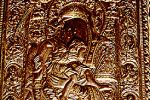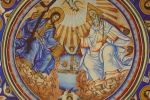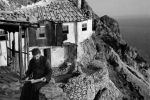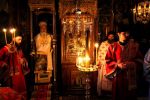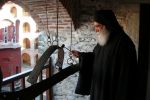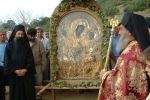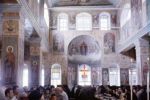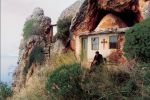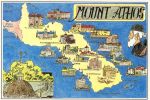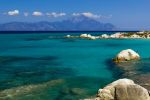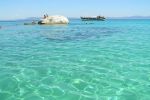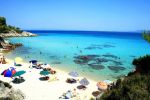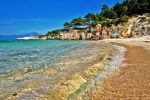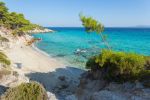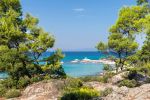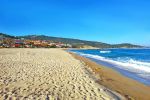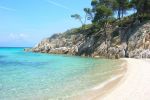History of Holy Mount Athos
Mythology
According to mythology the name Athos belongs to a Thracian giant. During the conflict between the Gods and the Giants, Athos threw a huge rock against Poseidon (the God), but the rock slipped through his fingers and fell to the sea creating a huge block of land which is now Mount Athos. In a different version it was Poseidon who threw the rock against Athos. The rock crushed Athos and burried him underneath. This rock was called Mount Athos.
Christianity
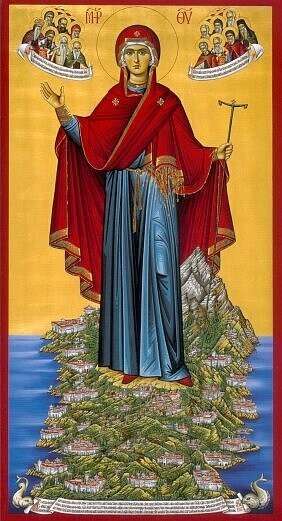 According to tradition, the Virgin Mary with John the Evangelist, or their way to visit Lazarus in Cyprus, encountered a stormy sea that forced them to temporarily seek refuge in the port which is now the Holy Monastery of Ivira. The Virgin Mary, admiring the wild beauty of the place, asked God to give her the mountain as a present. Then the voice of our Lord was heard saying: “Let this place be your lot, your garden and your paradise, as well as a salvation, a heaven for those who seek salvation”. Since then, Mount Athos is considered as “The Garden of the Virgin Mary”. In In the 5th century AD, the first monks came to Mount Athos, who disappointed from the boredom of everyday communal life, found this beautiful and uninhabited place ideal for worship their God.
According to tradition, the Virgin Mary with John the Evangelist, or their way to visit Lazarus in Cyprus, encountered a stormy sea that forced them to temporarily seek refuge in the port which is now the Holy Monastery of Ivira. The Virgin Mary, admiring the wild beauty of the place, asked God to give her the mountain as a present. Then the voice of our Lord was heard saying: “Let this place be your lot, your garden and your paradise, as well as a salvation, a heaven for those who seek salvation”. Since then, Mount Athos is considered as “The Garden of the Virgin Mary”. In In the 5th century AD, the first monks came to Mount Athos, who disappointed from the boredom of everyday communal life, found this beautiful and uninhabited place ideal for worship their God.
Agion Oros (Holy Mount) is an “Autonomous Monastic State” inside Greece, (unique in the world), located at peninsula of Athos of Chalkidiki, that is considered to be the centre Orthodoxe monasticism. It is considered to be one of the most important departments not only of Balkan, but of Europe and of Eastern Church because of its huge national, historical, religious, secretarial and artistic value as well as a centre of maintenance and conservation of rich material. The architectural heritage of Agion Oros, which is a result and residue of many years’ activity and development of many monastic institutions, can in one degree be considered as it summarises the medieval and newer architecture of orthodox Balkan space.
It is indeed a shelter and a museum of unique treasure of Greek art and letters. However the most important in the Agion Oros is the fact, that this expresses at the evener way the Orthodoxe monasticism. It is a thousand years solitary state that lives until today. A world simple and difficult, where it rests the spirit, fills the soul and it experiences the substance of Orthodoxy. A world that lives God oriented and during its thousand years historical route has as its main characteristic the high spirituality. The entire the life of nuns and all of their work are products of this spirituality. Each heirloom is a gate of sky, a gate in paradise.
Athos Geography
Mount Athos is situated in the entire third, eastern and most beautiful peninsula of Halkidiki, called the peninsula of Athos. It is the only place in Greece that is completely dedicated to prayer and worship of God. For this reason, it is called the Holy Mount. The Holy Mount is about 50 Km in length, 8 to 12 Km in width and it covers an area of about 350 square kilometres. The borders of the monasterial city are defined on the ground by an imaginary line that starts from the location “FRAGOKASTRO” in the West coast and reaches the cape “ARAPIS” in the opposite end. The natural beauty of the peninsula is extraordinary. The highest point of Mount Athos is like a huge cone, reaching 2033 metres in height. It’s a naked, treeless crest that seems to lance the sky and its slopes are fully covered by ancient evergreens. All these help to create an area of incomparable natural beauty.
Monasteries of Mount Athos
The independent and autonomous State of Mount Athos, better known as “Holy Mountain” consists of 20 monasteries, 17 of which are Greek, 1 is Bulgarian, 1 is Serbian and 1 is Russian. Even though the territory belongs to Greece, Mt. Athos is autonomous and is governed by the Ecumenical Patriarchy of Constantinople. The Holy Community’s head office is in Karyes, a small establishment practically in the middle of the peninsula on a hill overlooking the sea. All visitors of the Holy Mountain are obliged to report their arrival in Karyes. According to the strict orders regarding the forbidden entrance to women to the Mt. Athos State, only men are allowed to enter the Holy Territory and they have to have a written permission from the Holy Mountain Visitors Office in Thessaloniki (109 Egnatia St.).
On the Holy Mountain, apart from the 20 Monasteries, there are 12 sketes (ascetic corners), monastic places in the form of villages, cells, monks’ residences with a rural area around them and houses of retreat for those who have retreated away from the inhabited world.
Mount Athos was officially established in 963 when a monk named Athanasios the Athonite built the Monastery of Great Lavra. However, even prior, monks and hermits had begun to retire to that area. Today, it is divided into twenty self- governed territories and the total number of monks does not exceed 1,700. Each territory consists of a cardinal monastery and some other monastic establishments that surround it (cloisters, cells, cottages, seats, hermitages). All the monasteries are communes (of a convent nature) which mean that there is common liturgy, prayer, housing, nourishing and work among the monks. The Superior of the monastery, being elected by the monks for life, is responsible for the affairs of the monastery. The Superiors of the monasteries are members of the Holy Assembly and exercise legislative authority. The administrative centre of Mount Athos is the village of Karyes.
It is also worth noting that time on Mount Athos runs according to the Julian calendar, abandoned by most of Western Europe in favour of the present-day Gregorian calendar during the sixteenth century. This means that dates in the monastic republic are ten days behind the rest of us. An Edict issued in 1060 AD by the Byzantine Emperor Constantine Monomachos, laid down strict conditions as to who might be admitted, and forbade females from ever crossing its border. This prohibition is still enforced, and no female may set foot on Agion Oros.
For Greeks, Mount Athos is the cradle of their national traditions and a part of Greece that for over a thousand years has preserved their Greek-Christian traditions, literature and authentic Byzantine worship. It is a sacred repository housing still unknown sources for scholars investigating theology, philosophy, history, Byzantine and post-Byzantine art and eastern mysticism, and a boundless museum containing invaluable treasures and heirlooms of the Orthodox tradition.
The Monasteries, built as real fortresses on the windbeaten rocks of Athos, castles that stand proudly against the impious intruders, but also calm medication shelters, are a paradise of the soul, a place of love.
Please see the YouTube video: CBS - 60 minutes: A visit to the Holy Mountain











